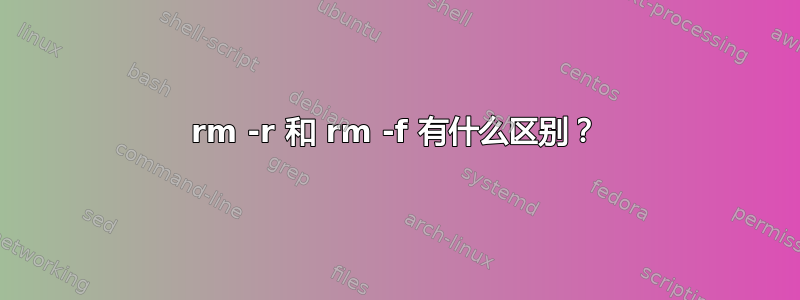
来自手册:
-f,--force
忽略不存在的文件,从不提示
-r、-R、——递归
递归删除目录的内容
虽然此选项描述不同,但当尝试删除一个空文件夹(此示例中没有 rmdir)时,它会产生相同的结果。
-f与之相比,不会打印错误或任何内容-r,这是唯一的区别吗?或者是否存在特定类型的情况,即一个选项比另一个选项更好,或者其中一个选项根本不起作用而另一个选项起作用的情况?
答案1
CentOS 的手册页是这样说的:
-f, --force
ignore nonexistent files, never prompt
-r, -R, --recursive
remove directories and their contents recursively
据我所知(感谢下面的一些评论),以下内容对于-r和-f标志是正确的:
-r
- 递归删除目录的内容,包括隐藏文件和子目录
- 根据您的配置,它可能会请求权限(例如,使用标志时
--interactive)。一些发行版默认执行此操作。 - 可用于删除目录,如果要这样做,只需给它目录的路径(例如
/path/to/directory:)
-F
- 不会递归删除目录的内容,仅删除与给定路径直接匹配的文件(例如
example/file1或example/*)。 - 永不删除子目录
- 从不请求许可,基本上
yes to all在 Windows 中
下面是一些示例,它们均以以下结构开头:
example/
file1
file2
file3
.file
dir/
file1
file2
file3
.file
我默认为这些示例启用了详细程度和交互模式。有些发行版这样做,而有些则不这样做。
rm 示例
$ rm example
rm: cannot remove `example': Is a directory
如您所见,rm默认情况下不会删除目录。
rm 示例 -f
$ rm example -f
rm: cannot remove `example': Is a directory
使用该-f标志仍然不允许它删除目录。
rm 示例 -r
$ rm example -r
rm: descend into directory `example'? yes
rm: remove regular empty file `example/file3'? yes
removed `example/file3'
rm: remove regular empty file `example/file2'? yes
removed `example/file2'
rm: descend into directory `example/dir'? yes
rm: remove regular empty file `example/dir/.file'? yes
removed `example/dir/.file'
rm: remove regular empty file `example/dir/file3'? yes
removed `example/dir/file3'
rm: remove regular empty file `example/dir/file2'? yes
removed `example/dir/file2'
rm: remove regular empty file `example/dir/file1'? yes
removed `example/dir/file1'
rm: remove directory `example/dir'? yes
removed directory: `example/dir'
rm: remove regular empty file `example/file1'? yes
removed `example/file1'
rm: remove directory `example'? yes
removed directory: `example'
如您所见,系统会要求您提供每个文件和目录的权限,隐藏文件也会被删除。
rm 示例/* -f
$ rm example/* -f
rm: cannot remove `example/dir': Is a directory
removed `example/file1'
removed `example/file2'
removed `example/file3'
在这里,您不需要获得许可,目录不会被删除,也不会有隐藏文件。
rm 示例/* -r
$ rm example/* -r
rm: descend into directory `example/dir'? yes
rm: remove regular empty file `example/dir/.file'? yes
removed `example/dir/.file'
rm: remove regular empty file `example/dir/file3'? yes
removed `example/dir/file3'
rm: remove regular empty file `example/dir/file2'? yes
removed `example/dir/file2'
rm: remove regular empty file `example/dir/file1'? yes
removed `example/dir/file1'
rm: remove directory `example/dir'? yes
removed directory: `example/dir'
rm: remove regular empty file `example/.file'? yes
removed `example/file'
rm: remove regular empty file `example/file1'? yes
removed `example/file1'
rm: remove regular empty file `example/file2'? yes
removed `example/file2'
rm: remove regular empty file `example/file3'? yes
removed `example/file3'
这里,示例目录的内容(而不是目录本身)被删除,包括隐藏文件。
答案2
rm -r mydir将删除mydir目录及其所有内容。
rm -f mydir不会删除目录(无论是空的还是有内容的)。它会报告一个错误:
在 BSD/OS X 上:
rm: mydir/: is a directory在 GNU/Linux 上:
rm: cannot remove 'mydir': Is a directory
无论给定什么参数,命令行为的可能解释rm(从最可能到最不可能):
- 你有一个定义的 shell 别名
rm,它将一些定义的参数(如-r)传递给rm命令 - 您正在调用一个名为的脚本
rm,该脚本还会将其他参数传递给实际命令 - 你有一个自定义的
rm可执行文件
您可以通过执行来验证前两种可能性/bin/rm -f mydir。


